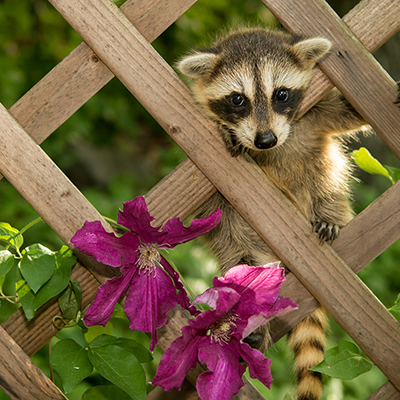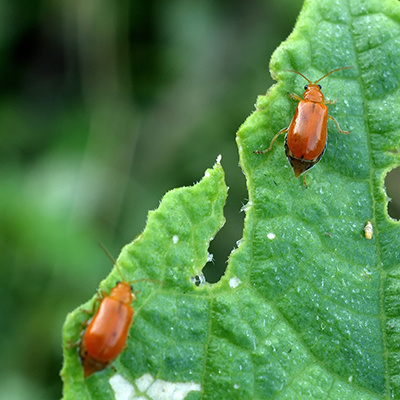How to Get Rid of Thrips

Last updated March 18, 2024
Thrips are common pests found in greenhouses, indoor plants and gardens. They damage plants by sucking their juices and scraping at fruits, flowers and leaves.
Thankfully, there are a few effective and organic methods to remove thrips and prevent infestations. This guide shows you how to identify and remove thrips.
Difficulty:
Beginner
Duration:
Under 2 hours
Table of Contents
What are Thrips?
How to Spot Thrips
Life Cycle of Thrips
What Thrips are Attracted To
Common Thrips Habitats
Signs of a Thrips Infestation
What are Thrips?

Thrips are small, slender insects that can be winged or flightless. Winged thrips have fringed double wings. They can vary in color from straw-colored to brown or black. (By the way, "thrips" is both singular and plural.)
Thrips belong to the order Thysanoptera which has more than 5,000 different species. Thrips have distinctive uneven mouthparts, with one mandible longer than the other.
Also known as thunder flies, thrips are sucking insects that can cause damage to plants. They can harm plants by carrying viruses from plant to plant.
How to Spot Thrips

Because thrips are so small, they can be hard to identify. Adult thrips measure less than 1/25 of an inch. If you try to get close they'll likely leap or fly away quickly. The nymphs look like smaller versions of adults, though they tend to be light green or yellow. Thrips look like tiny dark slivers on your plants.
If you suspect you see thrips, grab a white piece of paper or mail. Place it underneath the plant. Hold the stem of the leaf you think might have thrips and gently shake it. You may be able to see them more clearly on the white background. They’re likely to fly or bounce away quickly, so act fast.
Life Cycle of Thrips

Thrips adults and pupae overwinter in soil. In spring, females insert their eggs into the tissues of flowers, leaves and stems. Each female can produce up to 80 eggs. The eggs hatch into wingless larvae called nymphs. Thrips nymphs feed on plant sap. They then go through two or more nymphal stages before becoming adults.
There may be 12 to 15 generations of thrips per year with the entire cycle from egg to adult taking less than 16 days in warm weather. This quick life cycle makes them overwhelming and damaging garden pests.
What Thrips are Attracted To

Thrips are attracted to the colors blue and yellow. The plants they like most include azaleas, ferns, pyracantha, rhododendron and viburnum.
Thrips can make their way onto indoor plants by traveling on the leaves of houseplants that spent the summer outdoors. They can also hitch a ride from garden centers and greenhouses, or cut flowers or veggies you bring in from the garden. They search for new places to reproduce and can mature indoors or outside in warm weather.
Common Thrips Habitats

Thrips live on and around the plants they’re eating. They can be found on leaves and between layers of bark on trees. On other plants, they can be found on the leaves, stems or flower blossoms. Thrips enjoy hiding between the petal layers of roses and other flowering plants.
Tip: Indoor plants can also end up with a thrips infestation. Indoor plants that thrips prefer include orchids, pothos and other common houseplants.
Signs of a Thrips Infestation

The easiest way to tell if you have a thrips infestation on your plants is by checking the leaves and stems. Thrips damage all plants in the same way. They use their syringe-like mouths to extract liquid from the plant. This causes streaks, silvery speckling and small white patches on leaves, stems and petals.
If you have a large infestation, your plants may be stunted with damaged flowers and fruits. Thrips can also spread common garden plant diseases. The most common disease they transmit is spotted wilt virus, which damages tomato plants.
How to Prevent Thrips

Prevention is the best way to keep your garden healthy and free of thrips. Here are some ways to help prevent thrips from invading your garden:
- Tend your garden: Reduce the places where thrips may breed in order to prevent infestation. After pruning or pulling weeds, immediately remove plant debris. Thrips can lay eggs in slits they cut in live plant leaves and stems. They gain easier access to freshly pruned plants with open edges.
- Stay aware: Check your plants for damage and clusters of pests where leaves attach to stems. If you spot an infestation, remove the infested leaves and take action quickly.
- Double-check new plants: Check any plants you bring into your garden or home for signs of thrips damage. If you spot damage, toss the infested plants by securely bagging them and putting them in the trash. Don’t introduce infested plants to your compost pile.
- Use sticky traps: Sticky traps are commonly used in greenhouses. They are large squares of sticky paper with bright colors that attract common pests, including thrips. Winged thrips will be attracted to the bright colors and get caught on the sticky surface.
Tip: Even if you don’t suspect an infestation, it’s a good idea to add preventative measures to your gardening routine.
How to Get Rid of Thrips

Depending on the level of infestation, there are many ways to get rid of thrips. A thrips invasion can be controlled naturally using sticky traps and a watchful eye. If you already have an infestation, you’ll need to do more than take preventative measures. These are the best options for ridding plants of thrips:
- Spray: If an infestation is out of control, you’ll have to spray insecticide. Use a pyrethrin spray or another type of oil-based spray for the best results. This spray combines insecticide with fatty oils to smother and poison thrips.
- Introduce predators: Insects like minute pirate bugs, ladybugs, Trichogramma wasps and lacewings love to munch on thrips. They can help to naturally reduce thrips populations and prevent other pests from entering your garden.
- Soaps: Natural insecticidal soaps work best on a moderate infestation. They kill by suffocation or dehydration. Insecticidal soaps are also an effective leaf wash to remove honeydew, sooty mold and other debris from the leaves of indoor plants.
- Neem oil: Mix an organic pest control like neem oil with insecticidal soap for an extra layer of killing power while remaining environmentally friendly. Neem oil is also great for helping with insect and fungal disease issues in gardens.
Thrips are annoying garden pests, but one you can get rid of with the right know-how. Prevention, along with management tools and products keep your garden healthy all season long.
Looking for the supplies you need to manage your garden and keep thrips away from your plants? The Home Depot delivers online orders when and where you need them.



























